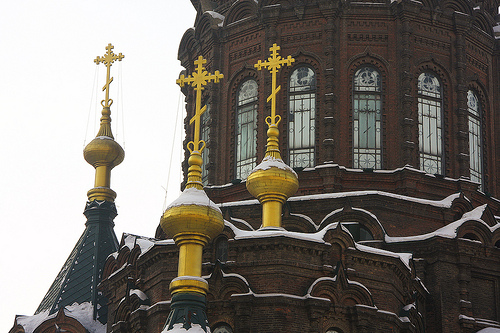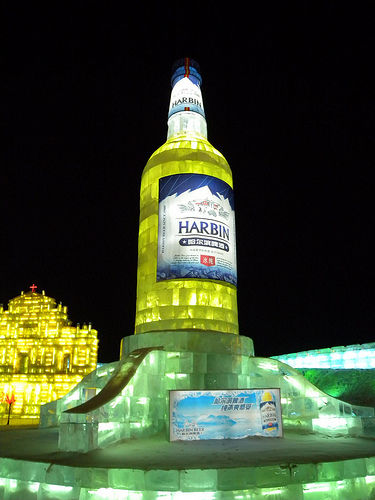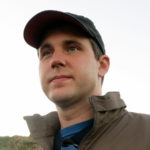Check out our Top Rewards Cards to boost your points earning and travel more!
Peter Conn’s teaching romp through China. Check out parts 1, 3, and 4.
Professor Peter Conn’s Manchuria sojourn concludes with a day as observant tourist, the park with trussed chickens for tiger food traded for a park with Russian female mud wrestlers. Revisit part 1, the laughs are just as delightful on replay.
Harbin is a moveable feast – A much less frenetic report.
The Chinese, as we know, are a very industrious people. This was brought home to me afresh on my first night in Harbin. My hotel room (more about this hotel in the following graph) faced a construction site. This I learned at precisely 5:00 a.m., when the clatter of hammers and power saws roused me rather abruptly from my sleep. Not as pleasant as rural birdsong, but equally effective. I stood at my window for some time watching the construction workers with as much benevolent curiosity as I could muster under the circumstances.
My guest house was a charming but somewhat tattered affair of peeling wallpaper, stained and fraying carpet, dripping faucets, and flickering light bulbs. Not the Waldorf, but perfectly adequate, with a comfortable bed that embraced my fatigued and elderly body. Until 5:00 a.m.
Taking advantage of my early start, I spent an hour or so walking around my portion of this remarkable city, the 10th largest in China and, with a population of ~10M, larger than any city in the US. Construction everywhere and, even at dawn, a bustle of cars and people. Many more courteous greetings than curious stares.
Harbin is popular with Korean and Russian tourists, and with Chinese tourists from the South escaping the summer heat. It is relatively cool here (80 or so) and certainly cooler than what you poor souls are going through back in the States. The Russian presence dates back to the 1890s, with the arrival of timber merchants, and grew exponentially in the 1920s when White Russians fled the Soviet regime.
This was the first day on which I did not have to lecture or travel or both. I pitched into a full twelve hours of tourism, accompanied by a wonderfully sharp and funny young man named Danny (I have changed his English nickname). Danny loves all things American, loathes the Party and government, and dreams of jumping ship as soon as he can. Our deal: for every question of mine about China he got to ask one about the US.
First stop (for all tourists) is Saint Sophia cathedral, a large and splendid Byzantine church that served the Russian community for half-a-century. The exterior is well preserved, little damaged either in the anti-Japanese war or in the calamity of Mao’s Cultural Revolution. The inside, on the contrary, is something of a noble wreck, diminished by decades of neglect. From the early 1950s, until the building was re-opened ten or so years ago, the damp and the rodents and pigeons had their way. Not so much restored as cleaned up and stabilized, the building is now a museum, devoted to photographs of life in pre-1949 Harbin. That is, life in Harbin prior to the year that the Party, with consummate Orwellian doublespeak, has always insisted on calling “the Liberation.”
The cathedral stands in a large and quite attractive plaza, surrounded by a mix of older and newer commercial buildings. I sat near a fountain gazing up like Kant at his steeple, trying to think important thoughts, about change and continuity, East and West. My musings had to compete with the music piped across the plaza from a cluster of loud speakers: a tinny rendition of “Happy Birthday,” on a continuous loop. Go figure.
Some blocks away, I spent more time that I had intended at the so-called New Jewish Synagogue, a pedestrian substitute for the older buildings that served Harbin’s Jewish community in the first four decades of the twentieth century. That population of Jews reached a peak of about 20,000. Harbin is one of several Chinese cities with important Jewish histories. The Jews of Kaifeng may have arrived as early as the sixteenth century, as Silk Road merchants who settled down. More famously, an estimated 30,000 Jews found sanctuary in Shanghai during the Second World War.
Like the cathedral, the synagogue is now a museum, but in this case dedicated to photographs (and quite eerie, George Segalesque, white life-sized sculptures) recalling Jewish flourishing as entrepreneurs, musicians, and scholars. One entire alcove is taken up with the story of Israel Epstein, a devout Communist and (a rare distinction for a Westerner) a Party member.
A lunch of hot pot preceded our afternoon on Sun Island, a gigantic combination playground and green space in the middle of the Songhua River. I followed a modest sign to the “flowers gardens” and was knocked over to find myself in one of the most extensive and beautiful gardens I’ve ever seen. (And you know that Mom and I are avid garden-bibbers.) As large as Regent Park, and as luxuriantly planted, and as well-maintained. I took a few pictures, which will be lousy but will give some idea of this treasure place. One of those especially good moments, because completely unexpected.
We visited “Russia Town,” acres of faux pre-Soviet huts and farmhouses, most fronted by life-size plaster statues of gnome-like serfs in their colorful costumes. The only and inadvertent gesture toward authenticity is that everything is dilapidated and falling down. Meretricious beyond my poor powers of description; and therefore delightful.
Then, again unexpectedly, a superb moment. Inside one of these shacks an elderly Chinese man has organized a display of his collection of early gramophones – Russian, French, English, American – all in working order. Pride of place naturally goes to a couple of Edison machines from the 1890s.
This provided me a double pleasure. Years ago, I was taken to one of Seoul’s suburbs, to visit a museum of Thomas Edison, filled by a wealthy Korean Edison groupie with hundreds of artifacts, gadgets, manuscripts, and photographs. Why this Edison compulsion in the East? And, I add, how many Westerners have conversed with both these guys?
We had paid Y20 (about $3) to walk around Russia Town. For another Y40, Danny told me, we could see “the performance.” What is “the performance,” I asked, and why does it cost twice as much as the entire exhibit? Blond Russian women in “small clothing,” Danny replied, wrestling in mud.
He was quite downcast when I told him that we would not be attending.
Back to the city center, and a mile-long central pedestrian street lined with shops, cafes and restaurants, along which families and young lovers and flaneurs ambulate. At Angela’s suggestion, we sought out “Modern – since 1906,” and had some of the best hand-made ice cream I have ever eaten (two scoops: one mango, one strawberry). The Central Street Music Festival was at full throttle. On one corner we listened to three guitarists playing a superb slow-dance arrangement of “Fly Me to the Moon.” Two blocks further, a quartet (flute, accordion, fiddle, guitar) were rocking to “Roll Out the Barrel.” I love all this globalization.
Then into a bar called Sta bucks. The original name had been Starbucks. Threatened by that other Starbucks with a lawsuit, the ingenious owner simply painted over all the “r’s.” In fact, this is a cheeky saloon send-up: entry through swinging doors into a dimly lit interior festooned with Old Western movie posters: the most forgettable films of Randolph Scott, Glenn Ford, Jane Russell and Audie Murphy here enjoy their afterlife. No John Wayne or Jimmy Stewart or Gary Cooper, perhaps because they were A-list and don’t need the proprietor’s memorial ministrations.
A wraith-like American nodded at me from a back table, and said hello, but his body language made it clear that we were not going to have a chat. For the next thirty minutes I glanced at him from time to time, nursing his beer and staring into some middle distance.
Here was another moment that rhymed oddly with a past one. Years ago, in Vientiane, Laos, Terry and I had a drink in a little bar cantilevered over the Mekong River. Nice spot, nice view, nice drink. In the corner, an American lost in his thoughts. He did exchange a few sentences with us before closing down: Vietnam vet, no intention of going back to the US. Running to or from what? Surviving how? Doing what each day?
Final report (for now)
When I first flew China domestic twenty-plus years ago, Chinese friends told me that the (now-defunct) initials CAAC stood for “China Airlines Always Crashes.” Later, as service improved, the gag changed to “China Airlines Always Cancels.” I can testify to the latter, but not, it presumably goes without saying, to the former.
Things have improved. My flight from Harbin to Beijing was timely and comfortable.
Except for the fellow sitting directly behind me – the sort of guy my daughter Alison calls “Mr. Bodily Functions Man” – who serenaded our crowded cabin for two hours with his (I hope not tubercular) hacking and wheezing. Like all audial intrusions, the din eventually faded into background white noise.
Almost.Guiyang (you will find it in the southwest of your map), is a lovely old town, set in the mountains; Guizhou University’s campus is thick with trees, hills, and gardens. My room is comfortable, with views of those mountains. Weather is warm (not hot) and generally dry. I read Pickwick on my borrowed kindle in one of the gardens, and miss all of you like crazy.
The classes are going well; the 25 teachers from far west China are attentive and good-humored, with English that ranges from excellent to fair. The walk to class takes me past the administration offices, in which (as in all Chinese universities) the party secretary’s name precedes the dean’s. I am told that this had become something of a joke in the earlier 2000s, but is a joke no longer. Like every other corner and nook and cranny of Chinese life, universities are feeling more pressure to conform to the party line. I met the secretary at an opening dinner, and hesitated before shaking his hand. I finally did so to avoid embarrassing my hosts. I think of him as the Eric Cantor of Guiyang.
The schedule is somewhat demanding: 90 minute lecture each morning, 60 minute Q&A each afternoon, and 60 minutes of unscripted “dialogue” most evenings. Food is good, but I long for a burger. (First dinner home will NOT be at Mustard Greens.)
Because I have now shifted into a routine of teaching for the next couple of weeks, nothing much of note is likely to happen – unless of course I am arrested as a spy. (The program has been the target of scurrilous nationalist blogging claiming a link with the CIA.) Barring that excitement, these reports will be replaced by occasional travel tips and odd sightings.
First tip: Chinese disposable razors should be disposed of before using.
Text by Peter Conn © 2011, all rights reserved, reprinted with permission. Reference hyperlinks and images selected by The Rapid Traveler, images licensed under Creative Commons.
Check Out Our: Top Rewards Cards ¦ Newsletter ¦ Twitter ¦ Facebook ¦ Instagram




